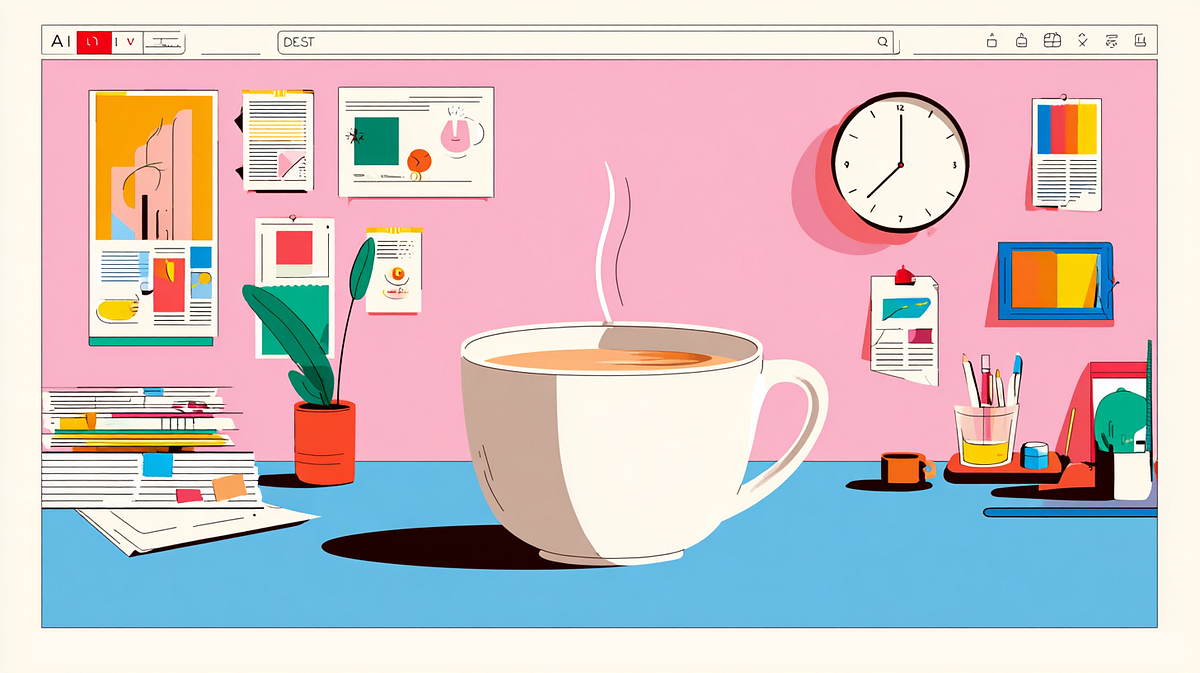If your research phase still looks like 27 tabs, three screenshots, and a prayer to the Pinterest gods, meet Atlas: OpenAI’s browser with ChatGPT built in.
It reads the page you’re on, keeps useful context, and (in Agent Mode) clicks around like a tireless studio assistant while you sip a flat white or whisk matcha. In this piece I’ll show you the exact Behance sweep I ran, the copy-paste prompts, and where Atlas fits alongside MidJourney, Firefly, and Figma — so your process feels less chaos, more Swiss-grid.
TL;DR
OpenAI’s Atlas is a browser with ChatGPT baked in. It reads the page you’re on, keeps useful context, and-in Agent Mode-can click around the web under your supervision to compile structured notes (titles, links, style takeaways, trend clusters). Think: Pinterest hunt + intern research + creative partner… inside your browser. Result: faster moodboards, cleaner competitor audits, tighter briefs, fewer tabs-and your taste still leads.
What is Atlas (and why should you care)?
Atlas is a Chromium-based browser where ChatGPT lives in your workflow, not off in some other tab. You get:
- A persistent sidebar to analyze whatever’s on-screen (no copy-paste gymnastics).
- Optional memories so Atlas remembers your project context (you control this).
- Agent Mode (preview) that can open tabs, click links, fill fields (with your OK), and hand you a tidy deliverable.
- If Chrome and a studio assistant had a baby raised on Swiss grids, iced coffee, and A24 mood lighting, it would be Atlas.
The 7-Minute Demo that sold me
Brief: curate Behance “coffee branding” into a table with links, one-line style reads, and emerging themes-i.e., moodboard-ready.
What I asked: “Go to behance.net → search ‘coffee branding.’ If Best of Behance exists, use it; else sort by Most Appreciated this month. Open the top 12 projects. For each: Title, Creator(s), URL, visible Tags/Industry, one-line style takeaway, and 3–5 approximate HEX colors from visible images (no downloads). Return one table + 5 emerging themes. If a page blocks extraction, skip and note why.”
What happened: Atlas did the clicking. I did three sets at the gym. Came back to a clean table and clear patterns: vintage scripts/serifs, minimal monochrome, artisan materials, playful color, retro geometry.
Translation: hours of intern work → 7 minutes. Less scraping, more designing.
Pro tip: keep confirmations on. Atlas asks before anything sensitive (logins/payments). You stay in control.
Learn how to integrate AI into your design workflow with the AI Branding Masterclass.
Copy-Paste Workflows (that clients actually feel)
Use Agent Mode when you want multi-site sweeps; use the sidebar when you’re already on the right page and want instant structure.
1) Cross-platform inspiration scan (Behance + Dribbble + Awwwards)
Open three tabs: Behance “coffee branding,” Dribbble “coffee brand identity,” Awwwards “coffee website.” From each, capture 6 strong references (title/author/link + one-line why it’s good). Deduplicate, then group all 18 into 4 visual territories with names and selection criteria. Links + text only.
Why it slaps: you get a curated museum tour and the gift shop receipt-ready to present.
2) Competitor voice audit (fast brand POV)
Analyze these 3 competitor homepages: [paste URLs]. Give me: primary value prop, tone/voice adjectives, headline patterns, proof claims, and a KEEP/CHANGE/CUT list for our brand. End with 5 slogan directions that avoid their clichés.
Why clients love it: it’s Paula-Scher-meets-McKinsey in two screens.
3) Video storyboard research (YouTube/TikTok/Vimeo)
Search “coffee brand ad,” “café opening film,” “product hero macro shots.” Collect 12 references with URLs and exact timecodes for standout shots (0:00–0:06, etc.). Label shot type (macro/slider/POV) + music vibe. Return as a table; propose a 6-scene storyboard.
Why it helps: your “mood reel” goes from squishy vibes to shot-list reality.
4) On-page SEO/AEO tune-up (for your case study/blog)
Assess this page. Propose tighter H1/H2, meta title (≤60), meta description (≤155), and a 3–5 Q&A FAQ section. Rewrite the intro in a designer-led tone. Return one copy-ready block.
Why it prints money: search engines understand you; humans actually read you.
Where Atlas fits with your current tools
Pinterest: keep it. Use Atlas to hunt and structure, then pin the gems for client boards.
Midjourney / Firefly: Atlas is the brief engine. It distills references and writes stronger prompts; you generate visuals with your tool of choice.
Figma/Adobe: Atlas is the research layer. Once you have territories, hop into design apps with clarity (and fewer “what if we also tried…” detours). Adobe just announced this week that they will be integrating Adobe tools into the apps available to ChatGPT. Watch this space!
Think of Atlas as your creative OS: research, organize, and decide faster-then execute in the tools you already love.
Limitations (and how to work with them)
- No auto mass-downloads: treat Atlas as a scout-collect links and notes, then save assets with licensing in mind.
- Agent Mode is preview: reliable for browsing and compiling; keep oversight on, especially on sketchy sites.
- Memories are optional: amazing for long projects; flip off/clear for sensitive gigs.
FAQ designers actually as
Does Atlas work on Mac only?
Launched on macOS, expanding over time. Check current availability.
Can it replace my researcher?
No-it elevates them (or you). Atlas does the slog; your taste makes the calls.
Will it make my work look same-same?
Only if your prompts are same-same. Use Atlas for breadth; bring the weird (your POV) for depth.
Originally published at https://www.houseofgai.com on October 30, 2025.
